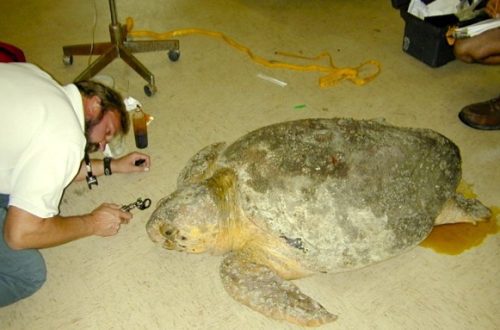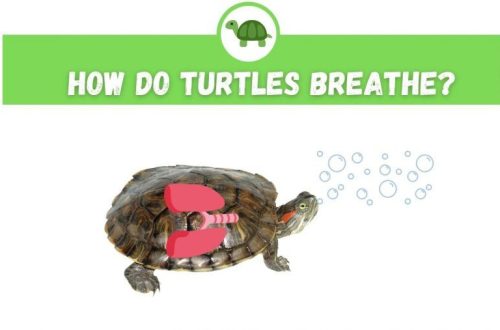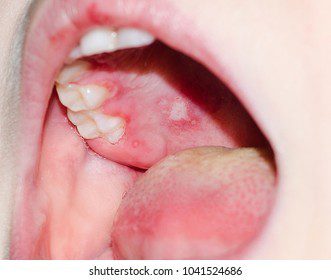
Mouth diseases (necrotic stomatitis, herpes, herpesvirosis)
Symptoms: difficulty breathing, refusal to feed, lethargy, yellow flakes in the mouth Turtles: more often small land Treatment: at the veterinarian, cured badly. INFECTIOUS to other turtles, not infectious to humans! Delay in treatment leads to the rapid death of the turtle.
Necrotic stomatitis 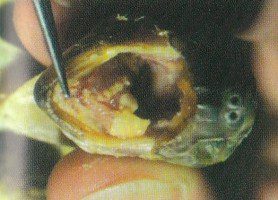
The reasons: This disease in turtles is not very common, and extremely rare – as an independent disease. In the latter case, the cause is almost always malocclusion associated with chronic hypovitaminosis A and osteomalacia. However, due to the specific structure of the oral cavity of turtles, the infection takes root poorly there. With malocclusion, the epithelium in the oral cavity can dry out and become necrotic, which is facilitated by the constant presence of food residues in the area that the tongue or lower jaw of the turtle cannot reach. However, a well-fed turtle kept at temperatures of 28-30°C almost never develops stomatitis, even if it has a malocclusion. Often stomatitis is observed in tortoises with exhaustion and keeping for 2 to 4 weeks at low temperatures (wintering, transportation, overexposure), such as turtles bought in August-September.
Symptoms: Excessive salivation, a small amount of transparent mucus in the oral cavity, the mucous membrane of the mouth with redness, or pale with cyanotic edema (dirty-white or yellow films are possible), dilated vessels are clearly visible, the turtle smells bad from the mouth. In the early stages of the disease, foci of hemorrhage or general mild hyperemia are found on the mucous membranes of the oral cavity. In the oral cavity – a small amount of transparent mucus containing desquamated epithelial cells. In the future, diphtheria inflammation develops, especially of the epithelium of the tongue and the inner gingival surface, which can lead to osteomyelitis, diffuse cellulitis and sepsis. There are flakes of pus in the mouth, which are tightly attached to the oral mucosa, or when they are removed, foci of erosion open. The disease can also have herpesvirus, mycoplasmal and mycobacterial etiology.
ATTENTION: The treatment regimens on the site can be obsolete! A turtle can have several diseases at once, and many diseases are difficult to diagnose without tests and examination by a veterinarian, therefore, before starting self-treatment, contact a veterinary clinic with a trusted herpetologist veterinarian, or our veterinary consultant on the forum.
Treatment: In mild forms and in the initial stage of the disease, strict isolation of sick animals and an increase in daytime temperatures to 32°C and night temperatures to 26-28°C are necessary. It is necessary to contact a veterinarian for a correct diagnosis, prescribing antibiotics and removing purulent material from the oral cavity and processing it.
Herpesvirus necrotizing stomatitis (herpesvirus pneumonia) of tortoises, herpesvirosisHerpesvirosis in tortoises is caused by a DNA virus from the Herpesviridae family (herpesviruses). In a typical case, clinical symptoms appear within 3-4 weeks after the acquisition of the turtle or after wintering. The earliest symptom of the disease is salivation, at this stage of the disease, as a rule, diphtheria overlays and other symptoms are absent. The disease proceeds within 2-20 days and ends with 60-100% death of the animal, depending on the type and age of the turtle.
Unfortunately, it is impossible to diagnose herpesvirosis in tortoises before a clinically advanced stage in Russia. In the laboratories of Europe and North America, veterinary herpetologists use serological diagnostic methods (neutralization reaction, ELISA) and PCR diagnostics for these purposes.
The reasons: 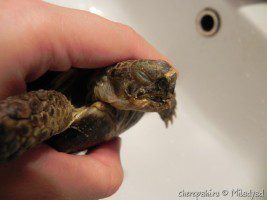 Incorrect maintenance, improperly conducted hibernation with exhaustion of the turtle’s body. Most often in newly purchased young tortoises, which were kept in poor conditions at low temperatures and were infected from relatives. Most often, such a disease can be found in turtles bought on the market or in a pet store in winter or early spring, because. these turtles were caught last year in May, transported incorrectly and kept incorrectly for a long time.
Incorrect maintenance, improperly conducted hibernation with exhaustion of the turtle’s body. Most often in newly purchased young tortoises, which were kept in poor conditions at low temperatures and were infected from relatives. Most often, such a disease can be found in turtles bought on the market or in a pet store in winter or early spring, because. these turtles were caught last year in May, transported incorrectly and kept incorrectly for a long time.
Symptoms: Herpesvirosis is characterized by lesions of the upper respiratory and digestive tracts. The disease manifests itself by the formation of diphtheric films on the mucous membranes of the tongue (yellow crusts), oral cavity, esophagus, nasopharynx, and turtle trachea. In addition, hepresvirosis is characterized by rhinitis, conjunctivitis, swelling of the ventral side of the neck, respiratory distress syndrome – nonspecific lung damage, neurological disorders, and occasionally diarrhea. You can often hear the tortoise squeaking as you exhale.
The disease is highly contagious. Quarantine required. In the early stages, it is difficult to visually isolate herpes, but it is better to transplant animals in which the oral mucosa is pale or yellowish.
Treatment: Treatment by a veterinarian is recommended. Very difficult to treat. First you need to make sure that the diagnosis is correct. If the turtle has been living with you for a long time and no new turtles have appeared at home, then most likely it is ordinary pneumonia.
The basis for the treatment of turtles with herpesvirosis is the antiviral drug acyclovir 80 mg/kg, which is injected into the stomach by tube once a day for 1-10 days, and acyclovir cream is also prescribed for application to the mucous membranes of the oral cavity. Systemically, veterinarians prescribe antimicrobial drugs to combat secondary infection – baytril 14%, ceftazidime, amikacin, etc. Antiseptic solutions – 2,5% chlorhexidine, dioxidine, etc.
Of great importance in the treatment of herpesvirosis is supportive therapy, including the introduction of polyionic solutions with glucose intravenously or subcutaneously, vitamin preparations (catosal, beplex, eleovit) and nutrient mixtures with a probe into the turtle’s stomach. Some veterinarians recommend an esophagostomy (creation of an artificial external esophageal fistula) for force feeding.
- Antibiotic Baytril 2,5% 0,4 ml / kg, every other day, course 7-10 times, intramuscularly in the shoulder. Or Amikacin 10 mg/kg, every other day, 5 times in total, IM in the upper arm or Ceftazidime.
- Ringer-Locke solution 15 ml / kg, adding 1 ml / kg of 5% ascorbic acid to it. A course of 6 injections every other day, under the skin of the thigh.
- Cut off the tip of the 14-18G gauge injection needle. Rinse the nostrils through this needle 2 times a day with Oftan-Idu / Anandin / Tsiprolet / Tsiprovet eye drops, drawing them into a syringe. After that, open the turtle’s mouth and carefully clean out all the purulent overlays from the very root of the tongue.
- In the morning, crush and pour on the tongue 1/10 of a tablet of Septefril (sold in Ukraine) or Decamethoxin or Lyzobact.
- In the evening, apply a little Zovirax cream (Acyclovir) on the tongue. Washing of the nostrils and treatment of mucous membranes continue for 2 weeks.
- Crush 100 mg tableted acyclovir (regular tablet = 200 mg, i.e. take 1/2 tablet), then boil the starch solution (take 12 tsp starch per glass in a glass of cold water, stir, slowly bring to a boil and cool) , measure out 2 ml of this jelly with a syringe, pour into a vial. Then pour and mix the crushed tablet well. Inject deep into the esophagus this mixture through a catheter, 0,2 ml / 100 g, daily, for 5 days. Then make a new batch, and so on. The general course is 10-14 days.
- Catosal or or any B-complex 1 ml/kg once every 1 days IM in the thigh.
- Bathe the turtle daily (before injections), in warm (32 degrees) water, for 30-40 minutes. In addition to rinsing the nostrils, clean the turtle’s mouth when shortness of breath occurs.
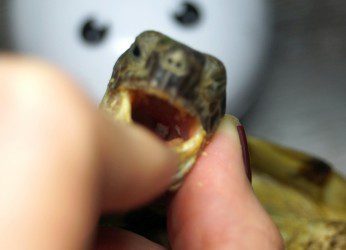
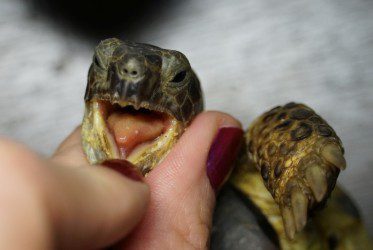
For treatment you need to buy:
1. Ringer-Locke solution | 1 vial | veterinary pharmacy Or Ringer’s or Hartmann’s solution | 1 vial | human pharmacy + glucose solution |1 pack| human pharmacy 2. Ascorbic acid | 1 pack of ampoules | human pharmacy 3. Fortum or its analogues | 1 vial | human pharmacy 4. Baytril 2,5% | 1 vial | veterinary pharmacy or amikacin | 0.5g | human pharmacy + water for injections | 1 pack| human pharmacy 5. Oftan-Idu or Tsiprolet or 0,05% Chlorhexidine, Dioxidine | 1 vial | human pharmacy or Tsiprovet, Anandin | veterinary pharmacy 6. Septefril (Ukraine) or other tablets based on Decamethoxine | 1 pack of tablets | human pharmacy (Decasan, Oftadec, Aurisan, Decamethoxin, Conjunctin, Septefril) or Lyzobact 7. Zovirax or Acyclovir | 1 pack of cream | human pharmacy 8. Aciclovir | 1 pack of tablets | human pharmacy 9. Catosal or any B-complex | 1 vial | veterinary pharmacy 10. Starch | grocery store 11. Syringes 1 ml, 2 ml, 10 ml | human pharmacy
Turtles that have been ill can remain latent virus carriers throughout their lives. During provocative episodes (wintering, stress, transportation, concomitant diseases, etc.), the virus can become activated and cause relapses of the disease, which are difficult to respond to etiotropic therapy with acyclovir.



